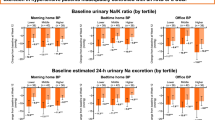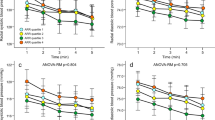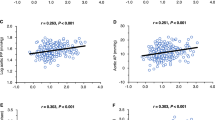Abstract
We investigated the interplay of dietary sodium and renin–angiotensin–aldosterone system (RAAS) activity with the prevalence of left ventricular hypertrophy (LVH) in essential hypertension. Electrocardiograms (EKG) were reviewed for the presence of LVH in 160 hypertensive patients. We then compared the rate of LVH to levels of plasma renin activity (PRA) and serum aldosterone under high and low sodium diet conditions. On high sodium diet, serum aldosterone was significantly higher (7.7±0.93 vs 5.7±0.35 ng/dl, P=0.02) in participants with LVH. With low sodium diet and upright posture, PRA was significantly lower in subjects with LVH vs those without (5.6±1.1 vs 7.6±0.56 ng/ml/h, P=0.026). Aldosterone levels on low sodium diet were not different between those with and those without LVH. PRA was then dichotomized at the lowest quartile under low sodium/upright posture conditions to define a ‘low renin’ group. In a multivariate logistic regression containing renin status (low renin vs normal/high renin), aldosterone on a high sodium diet, age, body mass index, gender, race, duration of hypertension, systolic and diastolic blood pressure and salt-sensitivity only low-renin status on a low sodium diet (P=0.019) and serum aldosterone on a high sodium diet (P=0.04) were significant predictors of LVH. Thus, reduced modulation of renin activity in response to sodium restriction and an increased aldosterone on a high sodium diet appear to identify characteristics of hypertensive patients predisposed to abnormal cardiac remodelling.
This is a preview of subscription content, access via your institution
Access options
Subscribe to this journal
Receive 12 digital issues and online access to articles
$119.00 per year
only $9.92 per issue
Buy this article
- Purchase on Springer Link
- Instant access to full article PDF
Prices may be subject to local taxes which are calculated during checkout


Similar content being viewed by others
References
Kannel WB, Sorlie P . Left ventricular hypertrophy in hypertension: prognostic and pathogenetic implications—The Framingham Study. In: Strauer B (ed). The Heart in Hypertension. Springer-Verlag: Berlin, 1981, pp 223–242.
Collins R, Peto R, Goodwin JSM . Blood pressure and coronary heart disease. Lancet 1990; 336: 370–371.
Koren MJ et al. Relation of left ventricular mass and geometry to morbidity and mortality in uncomplicated essential hypertension. Ann Intern Med 1991; 114: 345–352.
Vakili BA, Okin PM, Devereux RB . Prognostic significance of left ventricular hypertrophy. Am Heart J 2001; 141: 334–341.
Devereux RB et al. Left ventricular hypertrophy in hypertension. Prevalence and relationship to pathophysiologic variables. Hypertension 1987; 9: 1153–1160.
Verdecchia P et al. Prognostic significance of serial changes in left ventricular mass in essential hypertension. Circulation 1998; 97: 48–54.
Drayer JIM, Gardin JM, Breuer DD, Weber MA . Disparate relationship between blood pressure and left ventricular mass in patients with and without left ventricular hypertrophy. Hypertension 1987; 9(Suppl II): II-61–II-64.
Weber KT et al. Myocardial fibrosis: role of angiotensin II and aldosterone. Basic Res Cardiol 1993; 88 (Suppl 1): 107–124.
Mazzolai L et al. Increased cardiac angiotensin II levels induce right and left ventricular hypertrophy in normotensive mice. Hypertension 2000; 35: 985–991.
Du Cailar G, Ribstein J, Daures J-P, Mimran A . Sodium and left ventricular mass in untreated hypertensive and normotensive subjects. Am J Physiol 1992; 263: H177–H181.
Blake J et al. Relation of obesity, high sodium intake and eccentric left ventricular hypertrophy to left ventricular exercise dysfunction in essential hypertension. Am J Med 1990; 88: 477–485.
Baoxue Y, Leenen FHH . Dietary sodium intake and left ventricular hypertrophy in normotensive rats. Am J Physiol 1991; 261: H1397–H1401.
Aronow WS, Ahn C, Konnzon I, Gutstein H . Association of plasma renin activity and echocardiographic left ventricular hypertrophy with frequency of new coronary events and new atherothrombotic brain infarction in older persons with systemic hypertension. Am J Cardiol 1997; 79: 1543–1545.
Weber MA, Smith DH, Neutel JM . Differing roles of body mass and the renin–angiotensin system in mediating the hypertension syndrome. Am J Nephrol 2000; 20: 169–174.
Devereux RB, Savage DD, Drayer JIM, Laragh JH . Left ventricular hypertrophy and function in high, normal and low-renin forms of essential hypertension. Hypertension 1982; 4: 524–531.
Shigematsu Y et al. Clinical evidence for an association between left ventricular geometric adaptation and extracardiac target organ damage in essential hypertension. J Hypertens 1995; 13: 155–160.
Raji A et al. Insulin resistance in hypertensives: effect of salt sensitivity, renin status and sodium intake. J Hypertens 2001; 19 (Suppl): 99–105.
Fisher NDL et al. Altered adrenal sensitivity to angiotensin II in low-renin essential hypertension. Hypertension 1999; 34: 388–394.
Fisher NDL et al. Regulation of aldosterone secretion in hypertensive blacks. Hypertension 1994; 23: 179–184.
Ferri C et al. Hormonal and renal responses to atrial natriuretic peptide infusion in low-renin hypertension. Am J Nephrol 1995; 15: 222–229.
Tanabe A et al. Variability in the renin/aldosterone profile under random and standardized sampling conditions in primary aldosteronism. J Clin Endo Metab 2003; 88: 2489–2494.
Brown NJ et al. Effect of activation and inhibition of the renin–angiotensin system on plasma PAI-1. Hypertension 1998; 32: 965–971.
Casale PN et al. Improved sex-specific criteria of left ventricular hypertrophy for clinical and computer interpretation of electrocardiograms: validation with autopsy findings. Circulation 1987; 75: 565.
Dunn FG et al. Left ventricular hypertrophy and mortality in hypertension: an analysis of data from the Glasgow Blood Pressure Clinic. J Hypertens 1990; 8: 775–782.
Verdecchia P et al. Left ventricular hypertrophy as an independent predictor of acute cerebrovascular events in essential hypertension. Circulation 2001; 104: 2039–2044.
Kumpusalo E, Lappi J, Miettinen H, Takala J . Prevalence of left ventricular hypertrophy in Finnish primary health care hypertensive patients. J Hum Hypertens 2001; 15: 255–258.
Huston SL et al. Electrocardiographic left ventricular hypertrophy by five criteria among civil servants in Benin City, Nigeria: prevalence and correlates. Inter J Cardiol 1999; 70: 1–14.
Koga M et al. Plasma renin activity could be a useful predictor of left ventricular hypertrophy in essential hypertensives. J Hum Hypertens 1998; 12: 455–461.
Malmqvist K et al. Relationships between left ventricular mass and the renin–angiotensin system, catecholamines, insulin and leptin. J Intern Med 2002; 252: 430–439.
Rowlands DB et al. Assessment of left ventricular mass in its response to antihypertensive treatments. Lancet 1982; 1: 467–470.
Du Cailar G, Pasquie JL, Ribstein J, Mimran A . Left ventricular adaptation to hypertension and plasma renin activity. J Hum Hypertens 2000; 14: 181–188.
Tanabe A et al. Left ventricular hypertrophy is more prominent in patients with primary aldosteronism than in patients with other types of secondary hypertension. Hypertens Res—Clin Exper 1997; 20: 85–90.
Pessina AC, Sacchetto A, Rossi GP . Left ventricular anatomy and function in primary aldosteronism and renovascular hypertension. Advan Exp Med Biol 1997; 432: 63–69.
Dahlof B et al. Cardiovascular morbidity and mortality in the Losartan Intervention For Endpoint reduction in hypertension study (LIFE): a randomised trial against atenolol. Lancet 2002; 359: 995–1003.
Verdecchia P et al. Improved cardiovascular risk stratification by a simple ECG index in hypertension. Am J Hypertens 2003; 16: 646–652.
Devereux RB et al. Echocardiographic left ventricular geometry in hypertensive patients with electrocardiographic left ventricular hypertrophy: The LIFE Study. Blood Press 2001; 10: 74–82.
Acknowledgements
This research was supported by the following grants: National Institutes of Health Grants HL47651, HL59424, DK63214, Specialized Center of Research in Hypertension from the National Heart, Lung and Blood Institute (HL55000), National Center for Research Resources (General Clinical Research Centers) in Boston (M01 RR 02635) and Salt Lake City (M01 RR 00064). Dr J Williams was in part supported by an NIH training grant (T32 HL 0760917). We gratefully acknowledge the assistance of the dietary, nursing, administrative and laboratory staffs of the three clinical research centres.
Author information
Authors and Affiliations
Corresponding author
Rights and permissions
About this article
Cite this article
Williams, J., Williams, G., Jeunemaitre, X. et al. Influence of dietary sodium on the renin–angiotensin–aldosterone system and prevalence of left ventricular hypertrophy by EKG criteria. J Hum Hypertens 19, 133–138 (2005). https://doi.org/10.1038/sj.jhh.1001784
Received:
Revised:
Accepted:
Published:
Issue Date:
DOI: https://doi.org/10.1038/sj.jhh.1001784
Keywords
This article is cited by
-
Cardiac changes in pediatric liver transplant recipients: are they truly irreversible?
Hepatology International (2016)
-
Vitamin D and the vascular sensitivity to angiotensin II in obese Caucasians with hypertension
Journal of Human Hypertension (2011)
-
Dietary Sodium Alters the Prevalence of Electrocardiogram Determined Left Ventricular Hypertrophy in Hypertension
American Journal of Hypertension (2009)
-
Left ventricular hypertrophy and arterial wall thickening in children with essential hypertension
Pediatric Nephrology (2006)



